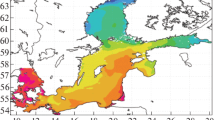Abstract
The domain reduction method uses a finite group of symmetries of a system of linear equations arising by discretization of partial differential equations to obtain a decomposition into independent subproblems, which can be solved in parallel. This paper develops a theory for this class of methods based on known results from group representation theory and algebras of finite groups. The main theoretical result is that if the problem splits into subproblems based on isomorphic subdomains, then the group of symmetries must be commutative. General decompositions are then obtained by nesting decompositions based on commutative groups of symmetries.
Zusammenfassung
Das Gebietszerlegungsverfahren verwendet eine endliche Symmetriegruppe des linearen Gleichungssystems, das bei der Diskretisierung von partiellen Differentialgleichungen entsteht, zur Erzeugung einer Zerlegung in unabhängige Teilprobleme, die parallel gelöst werden können. In dieser Arbeit entwickeln wir eine Theorie für diese Verfahrenskalsse, die sich auf Ergebnisse der Darstellungstheorie und der Algebra endlicher Gruppen stützt. Unser zentrales theoretisches Resultat besagt, daß die Symmetriegruppe kommutativ ist, wenn das Problem in Teilprobleme auf isomorphen Teilgebieten zerlegbar ist. Allgemeine Zerlegungen erhält man dann durch geschachtelte Zerlegungen auf Grund von kommutativen Symmetriegruppen.
Similar content being viewed by others
Explore related subjects
Discover the latest articles, news and stories from top researchers in related subjects.References
Allgower, E., Böhmer, K., Meiz Zhen.: A generalized equibranching lemma with applications inD 4×Z 2 symmetric elliptic problems. Part 1. Tech. Report 9, Philipps-Universität Marburg, Federal Republic of Germany, 1990.
Allgower, E. L., Böhmer, K., Georg, K., Miranda, R.: Exploiting symmetry in boundary element methods. Tech. Report. Colorado State University, Fort Collins, Colorado, May 1990. SIAM J. Numer. Anal. (submitted).
Brezzi, F., Douglas, C. C., Marini, L. D.: A parallel domain reduction method. Numer. Meth. PDE5, 195–202 (1989).
Douglas, C. C.: A tupleware approach to domain decomposition methods. Tech. Report 15360. IBM Research Division, Yorktown Heights, New York, 1990. Appl. Numer. Math. (in press).
Douglas, C. C., Kuznecov, Y.: Ficticious domains and the domain reduction method. In preparation, 1992.
Douglas, C. C., Mandel, J.: The domain reduction method: high way reduction in three dimensions and convergence with inexact solvers. In: Mandel, J., McCormick, S. F., Dendy, J. E., Farhat, C., Lonsdale, G., Parter, S. V., Ruge, J. W., Stüben, K., (eds.) Fourth copper mountain conference on multigrid methods. Soc. Ind. Appl. Math. 149–160 (1989).
Douglas, C. C., Miranker, W. L.: Constructive interference in parallel algorithms. SIAM J. Number. Anal.25, 376–398 (1988).
Douglas, C. C., Schultz, M. H.: Optimal domain reduction preconditioners. In preparation, 1992.
Douglas, C. C., Smith, B. F.: Using symmetries and antisymmetries to analyze a parallel multigrid algorithm. SIAM J. Numer. Anal.26, 1439–1461 (1989).
Golubitsky, M., Schaeffer, D.: Singularities and groups in bifurcation theory, Vol. 1. Berlin, Heidelberg, New York, Tokyo: Springer, 1985.
—, Singularities and groups in bifurcation theory, Vol. 2. Berlin, Heidelberg, New York, Tokyo: Springer, 1988.
Keown, R.: An introduction to group representation theory. New York: Academic Press 1975.
Munthe-Kaas, H.: Symmetric FFT's: A general approach. Tech. Report. Norwegian Institute of Technology, Trondheim, Norway, May 1989.
Van Der Waerden, B. L.: Gruppen von linearen Transformationen, vol. 4, number 2 of Ergebnisse der Mathematik und ihrer Grenzgebiete, Berlin, Heidelberg, New York: Springer, 1935.
Vilenkin, N. J.: Special functions and the theory of group representations. Trans. Math. Monogr., Amer. Math. Soc.22 (1968).
Author information
Authors and Affiliations
Additional information
Dedicated to Professor Willard L. Miranker on the occasion of his 60th birthday
Part of this research was done as a visitor to the Computational Mathematics Group, University of Colorado at Denver.
This research was partially sponsored by the National Science Foundation under grant DMS-9015259. Part of this research was done as a visitor to the Mathematical Sciences Department, IBM Thomas J. Watson Research Center.
Rights and permissions
About this article
Cite this article
Douglas, C.C., Mandel, J. An abstract theory for the domain reduction method. Computing 48, 73–96 (1992). https://doi.org/10.1007/BF02241707
Received:
Revised:
Issue Date:
DOI: https://doi.org/10.1007/BF02241707




